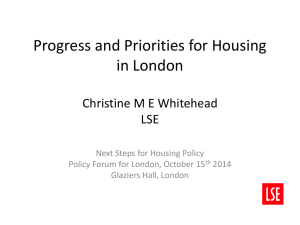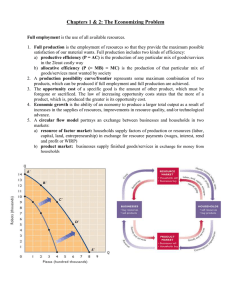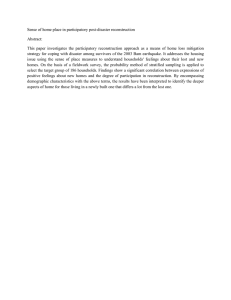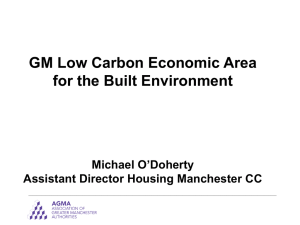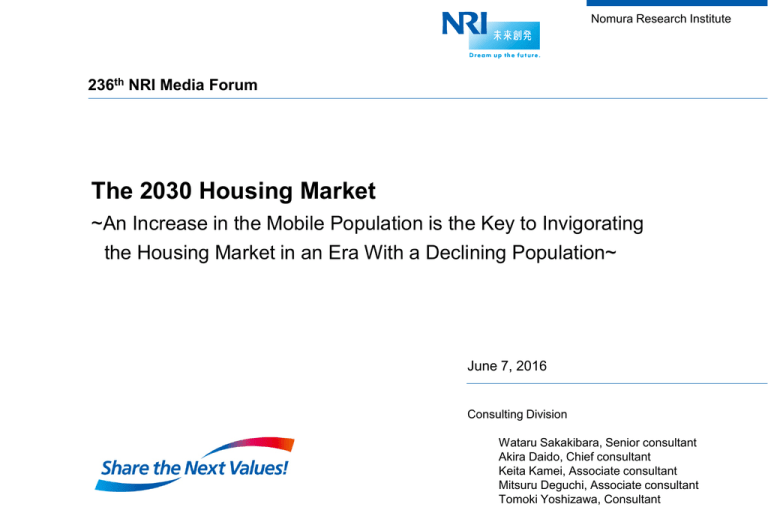
Nomura Research Institute
236th NRI Media Forum
The 2030 Housing Market
~An Increase in the Mobile Population is the Key to Invigorating
the Housing Market in an Era With a Declining Population~
June 7, 2016
Consulting Division
Wataru Sakakibara, Senior consultant
Akira Daido, Chief consultant
Keita Kamei, Associate consultant
Mitsuru Deguchi, Associate consultant
Tomoki Yoshizawa, Consultant
Contents
1. Predictions on new housing starts and the renovation market scale (2016 version)
2. Predictions on the number of vacant homes (2016 version)
3. Predictions on existing home sales
4. Summary
Copyright(C) Nomura Research Institute, Ltd. All rights reserved.
2
Contents
1. Predictions on new housing starts and the renovation market scale (2016 version)
2. Predictions on the number of vacant homes (2016 version)
3. Predictions on existing home sales
4. Summary
Copyright(C) Nomura Research Institute, Ltd. All rights reserved.
3
Factors that impact new housing starts
Three factors have major impacts on new housing starts: 1) Mobile population, 2) Nominal GDP
growth rate, and 3) Average age of housing stock.
Population and number
of households
•
•
•
•
Total population
Working-age population
Total number of households
Number of households in
which the head of household
is of working age
• Mobile population
• Number of mobile
households
etc.
Economic growth
•
•
•
•
•
•
•
•
Real GDP
Real GDP growth rate
Real GDP for the previous year
Real GDP growth rate for the
previous year
Nominal GDP
Nominal GDP growth rate
Nominal GDP for the previous year
Nominal GDP growth rate for the
previous year
Etc.
Housing stock
•
•
•
•
Total housing stock
Average age
Number of vacant homes
Vacancy rate
etc.
Is it logically relevant as a factor impacting new housing starts?
Can one say it impacts new housing starts statistically?
Factors that impact new housing starts
1) Mobile population 2) Nominal GDP growth rate 3) Average age of housing stock
Copyright(C) Nomura Research Institute, Ltd. All rights reserved.
4
Future predictions on factors that impact new housing starts (1)
The mobile population is expected to decrease from 10.1 million people in 2015 to
eight million people in 2030
Actual and predicted mobile population*
(One million people)
14
Actual values (estimates) ←
12.6
→ Predicted values
12
10.1
10
8.0
8
6
4
2
0
1988
1995
2000
2005
2010
2015
2020
2025
2030
(Year)
* Mobile population: the number of people that moved to a new address in the applicable year
Copyright(C) Nomura Research Institute, Ltd. All rights reserved.
Source) Actual values: Estimates by NRI based on the annual report on the internal migration in Japan derived
from the basic resident registers by the Ministry of Internal Affairs and Communications and Population Census
Predicted values: Predictions by NRI based on the Population Projections for Japan by the National
Institute of Population and Social Security Research.
5
Future predictions on factors that impact new housing starts (2)
Predictions by the Japan Center for Economic Research are used for the nominal GDP growth rate
(Growth power is decreasing in the mid to long term, and an era of negative growth will start around
2030)
Actual and predicted nominal GDP growth rate
(%)
9
8
7
6
5
4
3
2
1
0
-1
-2
-3
-4
-5
Actual values ←
→ Predicted values
2.1
1.5
-0.7
1988
1995
2000
2005
2010
2015
2020
2025
2030
(year)
Copyright(C) Nomura Research Institute, Ltd. All rights reserved.
Source) Actual values: System of National Accounts by the Cabinet Office
Predicted values: Mid-term economic forecast (announced March 23, 2016) by
the Japan Center for Economic Research
6
Future predictions on factors that impact new housing starts (3)
The average age of housing stock is expected to increase from 22 years in 2013 to
29 years in 2030
A decay curve was calculated, showing the degree of decrease after construction for housing stock according to the period in which construction
was started (right chart).
The average age was calculated by calculating the housing stock according to the year in which construction was started, based on the decay curve
(left chart).
Actual and predicted average age
(Year)
Actual values (estimates) ←
→ Predicted values
30
Decay curve (Housing stock decrease rate by period in which
construction was started)
1
0.9
0.8
25
0.7
0.6
1999~2003
0.5
15
10
0.4
1994~1998
0.3
1989~1993
1982~1988
0.2
5
0.1
0
0
1988
1995 2000 2005 2010 2015 2020 2025 2030 (year)
Copyright(C) Nomura Research Institute, Ltd. All rights reserved.
1971~1981
1961~1970
Period in which construction
was started
20
~1960
Until 1960
1 5 10 15 20 25 30 35 40 45 50 55 60 Age (years)
Source) Estimates and predictions by NRI based on the new housing starts Statistics by the Ministry of Land, Infrastructure,
Transport and Tourism and Housing and Land Statistics by the Ministry of Internal Affairs and Communications
7
New housing starts prediction results
New housing starts are expected to gradually decrease due to factors such as the
decreasing population, decreasing number of households, and longer life of housing,
totaling approximately 540,000 in 2030
Actual and predicted new housing starts
(10,000 homes)
180
Actual values ← → Predicted values
166167167
163
156
151
142
148 134
160
140
134
Collapse of the
bubble economy
120
100
123 121
125129
119
118
104
117 117
115
Last-minute
104
demand before the
consumption tax
increase
Falsified
+
earthquake
Reconstruction
resistance data
demand after the
scandal
Great Hanshin
Revision of the
Earthquake
Building
Standards Act
80
60
40
99
82 84
89
88
92
88
83 81
79 77
83
74 72
69 67
65 62
Last-minute
60 57
Bankruptcy demand before
54
78
of Lehman the consumption
Brothers
tax increase
20
0
1988
1995
2000
Copyright(C) Nomura Research Institute, Ltd. All rights reserved.
2005
2010
2015
2020
2025
2030
(year)
Source: Actual values: Construction starts statistics by the Ministry of Land, Infrastructure, Transport and Tourism
Predicted values:NRI
8
Factors that impact the renovation market scale
Three factors have major impacts on the renovation market scale: 1) New housing starts (8
years ago), 2) Nominal GDP growth rate, and 3) Average age of the housing stock
Economic growth
Number of households
• Total number of households
• Number of households in
which the head of household
is of working age
• Number of people moving
• Number of households
moving
• New housing starts
etc.
•
•
•
•
•
•
•
•
Real GDP
Real GDP growth rate
Real GDP for the previous year
Real GDP growth rate for the
previous year
Nominal GDP
Nominal GDP growth rate
Nominal GDP for the previous year
Nominal GDP growth rate for the
previous year
Etc.
Housing stock quality
• Average age
• Number of vacant homes
• Vacancy rate
etc.
Is it logically relevant as a factor impacting the renovation market scale?
Can one say it impacts the renovation market scale statistically?
Factors that impact the renovation market scale
1) New housing starts (8 years ago) 2) Nominal GDP growth rate 3) Average age of the housing
stock
Copyright(C) Nomura Research Institute, Ltd. All rights reserved.
9
Renovation market scale prediction results
Although growth is anticipated for the renovation market scale, expansion will be difficult if no measures are taken
In addition to policy support, inventive approaches by private business operators will also be necessary to invigorate
the market
Actual and predicted renovation market scale
Broad sense
(actual values)
(One trillion yen)
10
9.1
8.1
8.1
9
8
7
Broad sense
(predicted
values)
6.8
5.8
7.1 6.9
7.5
7.3 7.5 7.5 7.2 7.3 7.0
6.6
6.1
Narrow sense
(actual values)
Actual values ← → Predicted values
6.8
6.26.0 6.1
6
5
5.3
4
3
3.4 3.6
4.1
5.7
4.4 4.2 4.5
5.4
5.0 5.1
5.3 5.2
5.6 5.4
Narrow sense
(predicted values)
6.4
7.5 7.4
6.7 6.6
6.5 6.7
5.0
5.3 5.4
5.6
5.9 6.2
6.3 6.5
6.7 6.5 6.6 6.6
5.3 5.4
5.7 5.5 5.6 5.6 5.5 5.6 5.6 5.6 5.6 5.6
6.1 6.1
5.1
5.3
4.8 4.7 4.8
5.5 5.5
4.9 5.2
6.5 6.5 6.5 6.5 6.5 6.5
4.4
2
1
0
1989
1995
2000
2005
2010
2015
2020
2025
2030
(Year)
* Narrow sense: Building additions and reconstruction work included under “New housing” in the new housing starts statistics
Broad sense: Renovation market scale in the narrow sense with the amount including the purchase expenses for durable consumer
goods related to renovation (such as air conditioners and furniture), interior products, etc.
Source) Actual values: Housing Renovation Market Scale (2014 Version) by the Center for Housing Renovation and Dispute
Settlement Support. Predicted values: NRI
Copyright(C) Nomura Research Institute, Ltd. All rights reserved.
10
Contents
1. Predictions on new housing starts and the renovation market scale (2016 version)
2. Predictions on the number of vacant homes (2016 version)
3. Predictions on existing home sales
4. Summary
Copyright(C) Nomura Research Institute, Ltd. All rights reserved.
11
Prediction method
Predictions on the total Number of homes, number of vacant homes, and Vacancy
rate utilize the following method
Way of thinking for predicting the total Number of homes, number of vacant homes, and Vacancy rate
Total Number of
homes five years
ago
+
Actual values:Statistical Survey
on Housing and Land by the
Ministry of Internal Affairs and
Communications
Predicted values:NRI
Number of new
housing starts in
the five years after
-
Number of
demolished homes
in the five years after
=
Total number of
homes
Predictions by NRI
correlated with new
housing starts
Predicted values
by NRI
Vacancy rate
Number of
vacant homes
Total number
of homes
-
Number of
homes in which
households live
=
Number of homes
in which no
households live
Hypothesized to be the same level as future
predictions by the National Institute of
Population and Social Security Research
Number of homes
under construction
Number of homes
with temporary
residents only*
* homes in which not one
person normally lives, such
as those only used during
the day or those in which
several people take turns
staying at night
Divided
proportionally in
approximation of
past trends
Copyright(C) Nomura Research Institute, Ltd. All rights reserved.
12
Predictions on the total number of homes, number of vacant homes, and Vacancy rate
Together with the decreased number of households and increased total number of homes, the number
of vacant homes is expected to be roughly 21.67 million in 2033 with a vacancy rate of 30.4%
Actual and predicted total number of homes, number of vacant homes, and vacancy rate
(%)
(10,000 homes)
8,000
Actual values ←
7,000
5,759
6,000
6,063
6,367
6,646
7,126
30%
25%
25.7%
4,588
3,545
20%
21.1%
3,861
15%
16.9%
Vacancy rate
Total number of
homes and number
of vacant homes
5,389
4,201
4,000
6,900
30.4%
5,025
5,000
35%
→ Predicted values
3,000
11.5% 12.2%
2,000
1,000
7.6%
268
8.6%
330
13.1% 13.5%
9.4% 9.8%
394
448
576
659
2,167
1,773
757
820
1,078
10%
1,404
5%
0%
0
1978 1983 1988 1993 1998 2003 2008 2013 2018 2023 2028 2033 (Year)
Number of Vacant Homes (lefthand scale)
Total Number of Homes (lefthand scale)
Vacancy Rate (right-hand scale)
Copyright(C) Nomura Research Institute, Ltd. All rights reserved. Source) Actual values:Statistical Survey on Housing and Land by the Ministry of Internal Affairs and Communications
Predicted values:NRI
13
Predictions on the breakdown of vacant homes and ratio in the total Number of homes
The breakdown of vacant homes is approximately 12.7 million homes for rental or sale in 2033, accounting for
17.8% of the total Number of homes, and roughly 7.9 million other homes (those with no particular usage),
accounting for 11.0%
It is thought that other homes will continue increasing if homes are not demolished or downsized, and the
falling number of households will lead to more homes for rental or sale.
Actual and predicted breakdown of vacant homes and ratio in the total number of homes
(10,000
homes)
(%)
20%
1,400
18%
Actual values←→Predicted values
16%
Number of homes
1,000
14%
12%
800
10%
600
8%
6%
400
4%
200
2%
0
Ratio in the total Number of homes
1,200
0%
1978
1983
1988
1993
1998
2003
2008
2013
2018
2023
2028
2033 (年)
Number of secondary homes (left-hand
※別荘他
scale)
Number of homes for rental or sale (left-hand
scale)
Number of other homes (left-hand scale)
Ratio of secondary homes (right-hand
scale)
Ratio of homes for rental or sale (right-hand
scale)
Ratio of other homes (right-hand scale)
Copyright(C) Nomura Research Institute, Ltd. All rights reserved. Source) Actual values:Statistical Survey on Housing and Land by the Ministry of Internal Affairs and Communications
Predicted values:NRI
14
Contents
1. Predictions on new housing starts and the renovation market scale (2016 version)
2. Predictions on the number of vacant homes (2016 version)
3. Predictions on existing home sales
4. Summary
Copyright(C) Nomura Research Institute, Ltd. All rights reserved.
15
Prediction method
existing home sales were estimated and predicted based on information about the number of households and changes
in the home ownership ratio from external data, as well as the percentage of people buying a house for the first time
and percentage of people buying existing homes from NRI’s own surveys
Population Census (Ministry
of Internal Affairs and Communications),
Household Projections for
Japan
(National Institute of Population and
Social Security Research)
(A) Number of households
by age of head of
household (five-year age
segment)
Statistical Survey on
Housing and Land
NRI's questionnaire surveyNote)
(of homebuyers)
(Ministry of Internal Affairs
and Communications)
Note) An overview of the questionnaire survey is as follows.
• Online survey (name: Survey on Housing Acquisition)
• Targets: 9,204 men and women age 25 to 59 across Japan
who purchased a home each year from 2000
• Period: April 22 - 28, 2016
(B) Changes in the home
ownership ratio by age of
head of household (fiveyear age segment)
(C=A×B)
Number of households
purchasing a home for the first
time in the applicable period
(D) Among all households
purchasing a home, the
percentage of households
purchasing a home for the first
time
(F) Among all households
purchasing a home, the
percentage of households
purchasing an existing home
(E=C÷D)
Total number of households
purchasing a home
(not newly built)
(G=E×F)
Existing home sales
Copyright(C) Nomura Research Institute, Ltd. All rights reserved.
16
existing home sales estimation and prediction method (1)
Population Census (Ministry
of Internal Affairs and Communications),
Household Projections for
Japan
(National Institute of Population and
Social Security Research)
(A) Number of households
by age of head of
household (five-year age
segment)
Statistical Survey on
Housing and Land
NRI's questionnaire surveyNote)
(of homebuyers)
(Ministry of Internal Affairs
and Communications)
Note) An overview of the questionnaire survey is as follows.
• Online survey (name: Survey on Housing Acquisition)
• Targets: 9,204 men and women age 25 to 59 across Japan
who purchased a home each year from 2000
• Period: April 22 - 28, 2016
(B) Changes in the home
ownership ratio by age of
head of household (fiveyear age segment)
(C=A×B)
Number of households
purchasing a home for the first
time in the applicable period
(D) Among all households
purchasing a home, the
percentage of households
purchasing a home for the first
time
(F) Among all households
purchasing a home, the
percentage of households
purchasing an existing home
(E=C÷D)
Total number of households
purchasing a home
(not newly built)
(G=E×F)
Existing home sales
Copyright(C) Nomura Research Institute, Ltd. All rights reserved.
17
(A) Number of households by age of head of household (five-year age segment)
The number of households is expected to peak in 2019 and then declines to
around 51 million in 2030
Actual and predicted number of households (by age of head of household [five-year segment])
(10,000 households)
Actual values ←
6,000
→ Predicted values
5,307
5,123
5,000
<Age of head of household>
75歳以上
75
and older
70~74歳
70
– 74
65~69歳
65
– 69
4,000
60~64歳
60
– 64
55~59歳
55
– 59
3,000
50
– 54
50~54歳
45
– 49
45~49歳
40
– 44
40~44歳
2,000
35
– 39
35~39歳
30
– 34
30~34歳
25
– 29
25~29歳
1,000
25
or younger
25歳未満
0
2005
2010
Copyright(C) Nomura Research Institute, Ltd. All rights reserved.
2015
2020
2025
2030
(Year)
Source) Actual values: Population Census by the Ministry of Internal Affairs and Communications
Predicted values: Household Projections for Japan by the National Institute of Population and Social
Security Research
18
(B) Changes in the home ownership ratio by age of head of household (five-year age segment)
The home ownership ratio from 2018 on is assumed to be the same as 2013
The home ownership ratio for the demographic of people who were under age 25 in the 2003 survey is expected to
increase to roughly 46% in 2018
Actual and predicted home ownership ratio (by age of head of household [five-year segment])
Actual values ←
(%)
→ Predicted values
<Age of head of household>
100%
100
75 and older
70 - 74
80%
80
65 - 69
55 - 59
50 - 54
45 - 49
60%
60
40 - 44
45.8%
35 - 39
40%
40
28.5%
17.3pt increase
30 - 34
20%
20
11.5%
2.7%
17.0pt increase
25 - 29
8.8pt increase
25 and younger
0
0%
2003
2008
Copyright(C) Nomura Research Institute, Ltd. All rights reserved.
2013
2018
2023
2028
2033 (Year)
Source) Actual values: Statistical Survey on Housing and Land by the Ministry of Internal Affairs and
Communications (2003, 2008, 2013)
Predicted values: NRI
19
(C) Number of households purchasing a home for the first time in the applicable period
The cumulative number of households purchasing a home for the first time is expected to reach
approximately 2.75 million (yearly average of 550,000) for the five-year period from 2026 to 2030
Actual and predicted number of households purchasing a home for the first time (five-year cumulative number)
(Five-year cumulative number, 10,000 households)
350
300
250
200
150
100
50
0
2006-2010
2011-2015
Copyright(C) Nomura Research Institute, Ltd. All rights reserved.
2016-2020
2021-2025
2026-2030 (Year)
Source: Population Census, Population Estimates by the Ministry of Internal Affairs and Communications,
Household Projections for Japan by the National Institute of Population and Social Security Research,
Statistical Survey on Housing and Land by the Ministry of Internal Affairs and Communications
20
existing home sales estimates and estimate method (2)
Population Census (Ministry
of Internal Affairs and Communications),
Household Projections for
Japan
(National Institute of Population and
Social Security Research)
(A) Number of households
by age of head of
household (five-year age
segment)
Statistical Survey on
Housing and Land
NRI's questionnaire surveyNote)
(of homebuyers)
(Ministry of Internal Affairs
and Communications)
Note) An overview of the questionnaire survey is as follows.
• Online survey (name: Survey on Housing Acquisition)
• Targets: 9,204 men and women age 25 to 59 across Japan
who purchased a home each year from 2000
• Period: April 22 - 28, 2016
(B) Changes in the home
ownership ratio by age of
head of household (fiveyear age segment)
(C=A×B)
Number of households
purchasing a home for the first
time in the applicable period
(D) Among all households
purchasing a home, the
percentage of households
purchasing a home for the first
time
(F) Among all households
purchasing a home, the
percentage of households
purchasing an existing home
(not newly built)
(E=C÷D)
Total number of households
purchasing a home
(G=E×F)
Existing home sales
Copyright(C) Nomura Research Institute, Ltd. All rights reserved.
21
(D) Among all households purchasing a home, the percentage of households purchasing a home for the first time
The percentage of households purchasing a home for the first time in 2016 or later is estimated to be
77%, which is the average value calculated based on the results of a survey of homebuyers who
purchased a home in 2000 or later
Percentage of households purchasing a home for the first time among all households purchasing a home
First
purchase
初めて購入
Second or further purchase
2回目以降の購入
Average
平均値value
(%)
100
100%
The average value (76.7%) for the results of a
questionnaire survey of homebuyers in each year
from 2000 to 2015
80
80%
60
60%
40%
40
20%
20
0%
0
2000 2001 2002 2003 2004 2005 2006 2007 2008 2009 2010 2011 2012 2013 2014 2015 (Year)
Year of home purchase
Copyright(C) Nomura Research Institute, Ltd. All rights reserved.
Source) Questionnaire survey by NRI
22
(E) Total number of households purchasing a home
The cumulative total number of households purchasing a home is expected to reach approximately 3.6
million (yearly average of 720,000) for the five-year period from 2026 to 2030
Actual and predicted total number of households purchasing a home (five-year cumulative number)
(Five-year cumulative number, 10,000 households)
450
400
350
300
Total number
of households
purchasing a
home
250
200
150
100
(Reproduced)
Number of
households
purchasing
a home for
the first time
50
0
2006-2010
2011-2015
Copyright(C) Nomura Research Institute, Ltd. All rights reserved.
2016-2020
2021-2025
2026-2030
(Year)
Source: Population Census, Population Estimates by the Ministry of Internal Affairs and Communications, Household
Projections for Japan by the National Institute of Population and Social Security Research, Statistical Survey on Housing
and Land by the Ministry of Internal Affairs and Communications, questionnaire survey by NRI
23
existing home sales estimation and prediction method (3)
Population Census (Ministry
of Internal Affairs and Communications),
Household Projections for
Japan
(National Institute of Population and
Social Security Research)
(A) Number of households
by age of head of
household (five-year age
segment)
Statistical Survey on
Housing and Land
NRI's questionnaire surveyNote)
(of homebuyers)
(Ministry of Internal Affairs
and Communications)
Note) An overview of the questionnaire survey is as follows.
• Online survey (name: Survey on Housing Acquisition)
• Targets: 9,204 men and women age 25 to 59 across Japan
who purchased a home each year from 2000
• Period: April 22 - 28, 2016
(B) Changes in the home
ownership ratio by age of
head of household (fiveyear age segment)
(C=A×B)
Number of households
purchasing a home for the first
time in the applicable period
(D) Among all households
purchasing a home, the
percentage of households
purchasing a home for the first
time
(F) Among all households
purchasing a home, the
percentage of households
purchasing an existing home
(not newly built)
(E=C÷D)
Total number of households
purchasing a home
(G=E×F)
Existing home sales
Copyright(C) Nomura Research Institute, Ltd. All rights reserved.
24
(F) Among all households purchasing a home, the percentage of households purchasing an existing home (not newly built)
Assuming that the trend of increase from 2000 to 2015 will continue in 2016 and after, the percentage
of households buying existing homes other than newly built homes will reach approximately 48% in
2030
The ratio of people choosing existing homes is expected to continue increasing due to improved competitive power for existing homes
(quality, location, etc.) and consumer changes (values, income, etc.) in recent years (although there is still a major disparity compared
to Europe and the United States).
Actual and predicted percent of households purchasing an existing home (not newly built) among all households purchasing a home
Actual values ←
(estimates)
(%)
60
60%
Possibility of sudden fluctuation
caused by the Great East Japan
Earthquake
50%
50
40%
40
→ Predicted values
<Reference (from materials by the Ministry of Land, Infrastructure,
Transport and Tourism)>
US (2014): 83.1%
47.8%
UK (2012): 88.0%
Possibility of sudden fluctuation
caused by the bankruptcy of
Lehman Brothers
30%
30
28.8%
20%
20
Linear approximation based on the results of
a questionnaire survey of homebuyers in
each year from 2000 to 2015
(Determination coefficient: R2=0.96)
* However, 2010 and 2012 were excluded
from the linear approximation due to the
assumption that they were sudden
fluctuations
10%
10
0%
0
2000
2005
Copyright(C) Nomura Research Institute, Ltd. All rights reserved.
2010
2015
2020
2025
2030 (Year)
Source) Questionnaire survey by NRI
25
(G) existing home sales
Existing home sales are expected to continue increasing because of improved competitive
power for existing homes and consumer changes, reaching approximately 340,000 in 2030
Even if existing home sales increase favorably as NRI predicts, they will still be approximately 130,000 homes short
of the existing home sales policy objective (double the amount of 2013 by 2025) in the Basic Housing Plan (Cabinet
decision of March 2016).
Actual and predicted existing home sales
(10,000 units)
Actual values ←
(estimates)
50
→ Predicted values
40
Policy objective for existing home sales
(Double the amount of 2013)
Approximately 130,000 homes
30
20
30.7
33.6
2025
2030 (Year)
22.1
10
0
2005
2010
Copyright(C) Nomura Research Institute, Ltd. All rights reserved.
2015
2020
Source: Population Census, Population Estimates by the Ministry of Internal Affairs and Communications, Household
Projections for Japan by the National Institute of Population and Social Security Research, Statistical Survey on Housing
and Land by the Ministry of Internal Affairs and Communications, questionnaire survey by NRI
26
(Reference) Actual and predicted frequency of switching residences
An increase in the mobile population (moving, switching residences, replacement purchasing, etc.) is
essential for achieving the approximately 130,000 homes required to meet the existing home sales
target in an era with a declining population and number of households
Even if it is assumed that an increase in the mobile population will contribute only to existing home sales, it will be
necessary to increase the mobile population by 20% (from approximately 8.72 million to approximately 10.09 million
people).
Note) However, even though an increase in the mobile population should impact new housing starts as well as existing home
sales, specific quantification is not performed for these estimates.
Relationship between house sales and mobile population
Home
sales
(units)
If no measures
are taken
New
Existing
construc
homes
tion
(units)
(units)
Mobile
population
(people)
980,000 670,000 310,000 8.72 million
+130,000
units
If the existing
home sales
objective is
met
1.11
670,000
million
440,
000
1.2
times
10.09
million
Note) A simple existing home sales calculation method was established
based on the mobile population and nominal GDP, and the mobile
population was estimated if existing home sales total 1.11 million.
Copyright(C) Nomura Research Institute, Ltd. All rights reserved.
27
(Reference) Actual and predicted frequency of switching residences
Assuming that existing home sales of approximately 130,000 homes are achieved due to an increase in the mobile
population (moving, switching residences, replacement purchasing, etc.), one person must move, switch residences,
engage in replacement purchasing, etc. 7.1 times in his or her lifetime (around the 2009 level)
Actual and predicted residence switching frequency
Actual and predicted mobile population
(100 million people)
1.4
Actual values ←
(assuming an average life expectancy of 85)
(10,000 people) (Times)
→ Predicted values
1,400
9.0
1,200
1.2
The required mobile population is 10.09 million
1,000
1.0
Total population (left-hand scale)
総人口(左目盛)
800
Mobile population (right-hand scale)
移動人口(右目盛)
0.6
600
0.4
400
Mobile population
Total population
0.8
Actual values ←
(estimates)
200
0
0.0
1990 1995 2000 2005 2010 2015 2020 2025
Source) Actual values: Estimates by NRI based on the annual report on the internal migration in Japan derived from the basic
resident registers by the Ministry of Internal Affairs and Communications and Population Census
Predicted values: Predictions by NRI based on the Population Projections for Japan by the National Institute of
Population and Social Security Research
Copyright(C) Nomura Research Institute, Ltd. All rights reserved.
Moving, switching
residences, replacement
purchasing, etc. is required
7.1 times per lifetime (once
every 12 years)
8.0
7.0
6.0
0.2
→ Predicted values
If no measures are taken, the
residence switching frequency is
expected to decrease, reaching
6.1 times per lifetime (once every
14 years) in 2025
5.0
1990
1995
2000
2005
2010
2015
2020
2025
Source) NRI
28
Contents
1. Predictions on new housing starts and the renovation market scale (2016 version)
2. Predictions on the number of vacant homes (2016 version)
3. Predictions on existing home sales
4. Summary
Copyright(C) Nomura Research Institute, Ltd. All rights reserved.
29
Summary
New housing starts, which totaled 920,000 in 2015, are expected to decrease to approximately 540,000 in 2030. It will be
difficult to expand the scale of the renovation market, where growth is hoped for, without taking any measures to that end.
This market is predicted to level off at approximately six trillion yen (in the broad definition) by 2030.
NRI predicts that, if existing homes are not demolished or effectively used for non-residential purposes, the number of
vacant homes will reach roughly 21.7 million in 2033, and the Vacancy rate will reach 30.4%, both of which are increases.
Anticipating an impending era of full-scale decreases in population and the number of households, there is concern about a
long-term slump in the housing market. However, existing home sales are predicted to increase to approximately 220,000 in
2013, 310,000 in 2025, and 340,000 in 2030, which is one reason for a positive outlook.
However, even if existing home sales increase favorably as NRI predicts, they will not meet the policy objective (double the
amount of 2013 by 2025) in the Basic Housing Plan (Cabinet decision of March 2016).
An increase in the mobile population (moving, switching residences, replacement purchasing, etc.) is essential for further
invigorating existing home sales in an era with a declining population and number of households. To that end, initiatives
such as the following are necessary.
Establishing valuation systems for existing homes and enhancing loans for existing homes and renovations
Creating an environment that facilitates trial moving, residences in multiple regions, etc.
New business creation by private business operators (businesses to support moving, switching residences,
replacement purchasing, etc.)
NRI believes that an increase in the mobile population in an ageing society will have effects such as creating an
environment in which people can choose optimum housing depending on their life stage, as well as the qualitative
improvement of residential environments for consumers.
Copyright(C) Nomura Research Institute, Ltd. All rights reserved.
30

